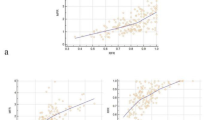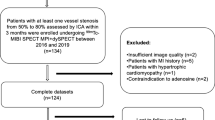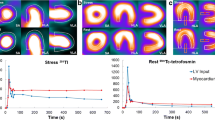Abstract
Background
The aim of this study was to investigate the feasibility and diagnostic value of myocardial flow reserve (MFR) assessed by rest/stress myocardial perfusion imaging with dynamic single-photon emission computed tomography (SPECT) in the functional evaluation of myocardial bridge (MB).
Methods
From May 2017 to July 2021, patients with angiographically confirmed isolated MB on the left anterior descending artery (LAD) who underwent dynamic SPECT myocardial perfusion imaging were retrospectively included. The assessment of semiquantitative indices of myocardial perfusion (summed stress scores, SSS) and quantitative parameters (MFR) was performed.
Results
A total of 49 patients were enrolled. The mean age of the subjects was 61.0 ± 9.0 years. All of the patients were symptomatic, and 16 cases (32.7%) presented with typical angina. SPECT-derived MFR showed a borderline significantly negative correlation with SSS (r = 0.261, P = .070). There was a trend of higher prevalence of impaired myocardial perfusion defined as MFR < 2 than as SSS ≥ 4 (42.9% vs 26.5%; P = .090).
Conclusion
Our data support that SPECT MFR may be a useful parameter for the functional assessment of MB. In patients with MB, the use of dynamic SPECT could be a potential method for hemodynamic assessment.





Similar content being viewed by others
Abbreviations
- MB:
-
Myocardial bridging
- LAD:
-
Left anterior descending artery
- MFR:
-
Myocardial flow reserve
- CZT:
-
Cadmium-zinc-telluride
- MBF:
-
Myocardial blood flow
- DS:
-
Diameter stenosis
- QCA:
-
Quantitative coronary angiography
- ROI:
-
Region of interest
- SSS:
-
Summed stress scores
- ROC:
-
Receiver operating characteristic
References
Alegria JR, Herrmann J, Holmes DR Jr, Lerman A, Rihal CS. Myocardial bridging. Eur Heart J 2005;26:1159‐68.
Tarantini G, Migliore F, Cademartiri F, Fraccaro C, Iliceto S. Left anterior descending artery myocardial bridging: A clinical approach. J Am Coll Cardiol 2016;68:2887‐99.
Ge J, Erbel R, Rupprecht HJ, Koch L, Kearney P, Gorge G. Comparison of intravascular ultrasound and angiography in the assessment of myocardial bridging. Circulation 1994;89:1725‐32.
Rihal C, Ammash N. Intramural course of coronary arteries: A bridge too far no more. JACC Cardiovasc Imaging 2017;10:1459‐60.
Rubinshtein R, Gaspar T, Lewis BS, Prasad A, Peled N, Halon DA. Long-term prognosis and outcome in patients with a chest pain syndrome and myocardial bridging: A 64-slice coronary computed tomography angiography study. Eur Heart J Cardiovasc Imaging 2013;14:579‐85.
Ge J, Jeremias A, Rupp A, Abels M, Baumgart D, Liu F, et al. New signs characteristic of myocardial bridging demonstrated by intracoronary ultrasound and Doppler. Eur Heart J 1999;20:1707‐16.
Tio RA, Van Gelder IC, Boonstra PW, Crijns HJ. Myocardial bridging in a survivor of sudden cardiac near-death: Role of intracoronary Doppler flow measurements and angiography during dobutamine stress in the clinical evaluation. Heart 1997;77:280‐2.
Corban MT, Hung OY, Eshtehardi P, Rasoul-Arzrumly E, McDaniel M, Mekonnen G, et al. Myocardial bridging: Contemporary understanding of pathophysiology with implications for diagnostic and therapeutic strategies. J Am Coll Cardiol 2014;63:2346‐55.
Bourassa MG, Butnaru A, Lesperance J, Tardif JC. Symptomatic myocardial bridges: Overview of ischemic mechanisms and current diagnostic and treatment strategies. J Am Coll Cardiol 2003;41:351‐9.
Kogame N, Ono M, Kawashima H, Tomaniak M, Hara H, Leipsic J, et al. The impact of coronary physiology on contemporary clinical decision making. JACC Cardiovasc Interv 2020;13:1617‐38.
Villemain O, Baranger J, Jalal Z, Lam C, Calais J, Pernot M, et al. Non-invasive imaging techniques to assess myocardial perfusion. Expert Rev Med Devices 2020;17:1133‐44.
Di Carli MF. PET perfusion and flow assessment: Tomorrows’ technology today. Semin Nucl Med 2020;50:227‐37.
Panjer M, Dobrolinska M, Wagenaar NRL, Slart R. Diagnostic accuracy of dynamic CZT-SPECT in coronary artery disease. A systematic review and meta-analysis. J Nucl Cardiol 2021. https://doi.org/10.1007/s12350-021-02721-8.
Zavadovsky KV, Mochula AV, Maltseva AN, Shipulin VV, Sazonova SI, Gulya MO, et al. The current status of CZT SPECT myocardial blood flow and reserve assessment: Tips and tricks. J Nucl Cardiol 2021. https://doi.org/10.1007/s12350-021-02620-y.
Aleksandric SB, Djordjevic-Dikic AD, Dobric MR, Giga VL, Soldatovic IA, Vukcevic V, et al. Functional assessment of myocardial bridging with conventional and diastolic fractional flow reserve: Vasodilator versus inotropic provocation. J Am Heart Assoc 2021;10:e020597.
Li C, Xu R, Yao K, Zhang J, Chen S, Pang L, et al. Functional significance of intermediate coronary stenosis in patients with single-vessel coronary artery disease: A comparison of dynamic SPECT coronary flow reserve with intracoronary pressure-derived fractional flow reserve (FFR). J Nucl Cardiol 2020. https://doi.org/10.1007/s12350-020-02293-z.
Leppo JA, Meerdink DJ. Comparison of the myocardial uptake of a technetium-labeled isonitrile analogue and thallium. Circ Res 1989;65:632‐9.
Hachamovitch R, Berman DS, Shaw LJ, Kiat H, Cohen I, Cabico JA, et al. Incremental prognostic value of myocardial perfusion single photon emission computed tomography for the prediction of cardiac death: Differential stratification for risk of cardiac death and myocardial infarction. Circulation 1998;97:535‐43.
Gawor R, Kusmierek J, Plachcinska A, Bienkiewicz M, Drozdz J, Piotrowski G, et al. Myocardial perfusion GSPECT imaging in patients with myocardial bridging. J Nucl Cardiol 2011;18:1059‐65.
Ben-Haim S, Murthy VL, Breault C, Allie R, Sitek A, Roth N, et al. Quantification of myocardial perfusion reserve using dynamic SPECT imaging in humans: A feasibility study. J Nucl Med 2013;54:873‐9.
Wang L, Wu D, Yang Y, Chen IJ, Lin CY, Hsu B, et al. Avoiding full corrections in dynamic SPECT images impacts the performance of SPECT myocardial blood flow quantitation. J Nucl Cardiol 2017;24:1332‐46.
Cortigiani L, Rigo F, Gherardi S, Bovenzi F, Molinaro S, Picano E, et al. Prognostic implication of Doppler echocardiographic derived coronary flow reserve in patients with left bundle branch block. Eur Heart J 2013;34:364‐73.
Patil HR, Bateman TM, McGhie AI, Burgett EV, Courter SA, Case JA, et al. Diagnostic accuracy of high-resolution attenuation-corrected Anger-camera SPECT in the detection of coronary artery disease. J Nucl Cardiol 2014;21:127‐34.
Miller DD, Younis LT, Chaitman BR, Stratmann H. Diagnostic accuracy of dipyridamole technetium 99m-labeled sestamibi myocardial tomography for detection of coronary artery disease. J Nucl Cardiol 1997;4:18‐24.
Wang J, Li S, Chen W, Chen Y, Pang Z, Li J. Diagnostic efficiency of quantification of myocardial blood flow and coronary flow reserve with CZT dynamic SPECT imaging for patients with suspected coronary artery disease: A comparative study with traditional semi-quantitative evaluation. Cardiovasc Diagn Ther 2021;11:56‐67.
Pijls NH, Sels JW. Functional measurement of coronary stenosis. J Am Coll Cardiol 2012;59:1045‐57.
van Nunen LX, Zimmermann FM, Tonino PA, Barbato E, Baumbach A, Engstrom T, et al. Fractional flow reserve versus angiography for guidance of PCI in patients with multivessel coronary artery disease (FAME): 5-year follow-up of a randomised controlled trial. Lancet 2015;386:1853‐60.
Escaned J, Cortes J, Flores A, Goicolea J, Alfonso F, Hernandez R, et al. Importance of diastolic fractional flow reserve and dobutamine challenge in physiologic assessment of myocardial bridging. J Am Coll Cardiol 2003;42:226‐33.
Pargaonkar VS, Kimura T, Kameda R, Tanaka S, Yamada R, Schwartz JG, et al. Invasive assessment of myocardial bridging in patients with angina and no obstructive coronary artery disease. EuroIntervention 2021;16:1070‐8.
Monroy-Gonzalez AG, Alexanderson-Rosas E, Prakken NHJ, Juarez-Orozco LE, Walls-Laguarda L, Berrios-Barcenas EA, et al. Myocardial bridging of the left anterior descending coronary artery is associated with reduced myocardial perfusion reserve: A (13)N-ammonia PET study. Int J Cardiovasc Imaging 2019;35:375‐82.
Taqueti VR, Di Carli MF. Coronary microvascular disease pathogenic mechanisms and therapeutic options: JACC state-of-the-art review. J Am Coll Cardiol 2018;72:2625‐41.
Sara JDS, Corban MT, Prasad M, Prasad A, Gulati R, Lerman LO, et al. Prevalence of myocardial bridging associated with coronary endothelial dysfunction in patients with chest pain and non-obstructive coronary artery disease. EuroIntervention 2020;15:1262‐8.
Montone RA, Gurgoglione FL, Del Buono MG, Rinaldi R, Meucci MC, Iannaccone G, et al. Interplay between myocardial bridging and coronary spasm in patients with myocardial ischemia and non-obstructive coronary arteries: Pathogenic and prognostic implications. J Am Heart Assoc 2021;10:e020535.
Reynolds HR, Maehara A, Kwong RY, Sedlak T, Saw J, Smilowitz NR, et al. Coronary optical coherence tomography and cardiac magnetic resonance imaging to determine underlying causes of myocardial infarction with nonobstructive coronary arteries in women. Circulation 2021;143:624‐40.
Zampella E, Mannarino T, D’Antonio A, Assante R, Gaudieri V, Buongiorno P, et al. Prediction of outcome by (82)Rb PET/CT in patients with ischemia and nonobstructive coronary arteries. J Nucl Cardiol 2022. https://doi.org/10.1007/s12350-022-03144-9.
Acknowledgements
This work was supported by grant from the National Natural Science Foundation of China (No. 81770429) and Shanghai Pujiang Program (Nos. 22PJD011 and 22PJD012).
Author information
Authors and Affiliations
Corresponding authors
Ethics declarations
Disclosures
All of the authors have no conflict of interest to declare.
Additional information
Publisher's Note
Springer Nature remains neutral with regard to jurisdictional claims in published maps and institutional affiliations.
The authors of this article have provided a PowerPoint file, available for download at SpringerLink, which summarises the contents of the paper and is free for re-use at meetings and presentations. Search for the article DOI on SpringerLink.com.
The authors have also provided an audio summary of the article, which is available to download as ESM, or to listen to via the JNC/ASNC Podcast.
Supplementary Information
Below is the link to the electronic supplementary material.
Rights and permissions
Springer Nature or its licensor (e.g. a society or other partner) holds exclusive rights to this article under a publishing agreement with the author(s) or other rightsholder(s); author self-archiving of the accepted manuscript version of this article is solely governed by the terms of such publishing agreement and applicable law.
About this article
Cite this article
Xu, R., Yang, H., Zhang, J. et al. Dynamic perfusion SPECT for functional evaluation in symptomatic patients with myocardial bridging. J. Nucl. Cardiol. 30, 2058–2067 (2023). https://doi.org/10.1007/s12350-023-03241-3
Received:
Accepted:
Published:
Issue Date:
DOI: https://doi.org/10.1007/s12350-023-03241-3




